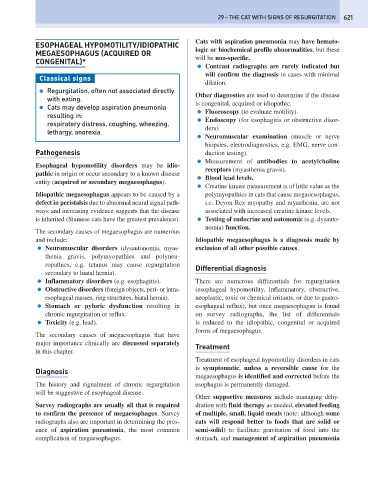Page 629 - Problem-Based Feline Medicine
P. 629
29 – THE CAT WITH SIGNS OF REGURGITATION 621
Cats with aspiration pneumonia may have hemato-
ESOPHAGEAL HYPOMOTILITY/IDIOPATHIC
MEGAESOPHAGUS (ACQUIRED OR logic or biochemical profile abnormalities, but these
CONGENITAL)* will be non-specific.
● Contrast radiographs are rarely indicated but
will confirm the diagnosis in cases with minimal
Classical signs
dilation.
● Regurgitation, often not associated directly
Other diagnostics are used to determine if the disease
with eating.
is congenital, acquired or idiopathic.
● Cats may develop aspiration pneumonia
● Fluoroscopy (to evaluate motility).
resulting in:
● Endoscopy (for esophagitis or obstructive disor-
respiratory distress, coughing, wheezing,
ders).
lethargy, anorexia.
● Neuromuscular examination (muscle or nerve
biopsies, electrodiagnostics, e.g. EMG, nerve con-
Pathogenesis duction testing).
● Measurement of antibodies to acetylcholine
Esophageal hypomotility disorders may be idio-
receptors (myasthenia gravis).
pathic in origin or occur secondary to a known disease
● Blood lead levels.
entity (acquired or secondary megaesophagus).
● Creatine kinase measurement is of little value as the
Idiopathic megaesophagus appears to be caused by a polymyopathies in cats that cause megaoesophagus,
defect in peristalsis due to abnormal neural signal path- i.e. Devon Rex myopathy and myasthenia, are not
ways and increasing evidence suggests that the disease associated with increased creatine kinase levels.
is inherited (Siamese cats have the greatest prevalence). ● Testing of endocrine and autonomic (e.g. dysauto-
nomia) function.
The secondary causes of megaesophagus are numerous
and include: Idiopathic megaesophagus is a diagnosis made by
● Neuromuscular disorders (dysautonomia, myas- exclusion of all other possible causes.
thenia gravis, polymyopathies and polyneu-
ropathies, e.g. tetanus may cause regurgitation
Differential diagnosis
secondary to hiatal hernia).
● Inflammatory disorders (e.g. esophagitis). There are numerous differentials for regurgitation
● Obstructive disorders (foreign objects, peri- or intra- (esophageal hypomotility, inflammatory, obstructive,
esophageal masses, ring structures, hiatal hernia). neoplastic, toxic or chemical irritants, or due to gastro-
● Stomach or pyloric dysfunction resulting in esophageal reflux), but once megaesophagus is found
chronic regurgitation or reflux. on survey radiographs, the list of differentials
● Toxicity (e.g. lead). is reduced to the idiopathic, congenital or acquired
forms of megaesophagus.
The secondary causes of megaesophagus that have
major importance clinically are discussed separately
Treatment
in this chapter.
Treatment of esophageal hypomotility disorders in cats
is symptomatic, unless a reversible cause for the
Diagnosis
megaesophagus is identified and corrected before the
The history and signalment of chronic regurgitation esophagus is permanently damaged.
will be suggestive of esophageal disease.
Other supportive measures include managing dehy-
Survey radiographs are usually all that is required dration with fluid therapy as needed, elevated feeding
to confirm the presence of megaesophagus. Survey of multiple, small, liquid meals (note: although some
radiographs also are important in determining the pres- cats will respond better to foods that are solid or
ence of aspiration pneumonia, the most common semi-solid) to facilitate gravitation of food into the
complication of megaesophagus. stomach, and management of aspiration pneumonia

